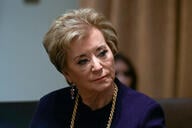You have /5 articles left.
Sign up for a free account or log in.
There’s no clearer indication that what happened at the University of Virginia last summer touched a sensitive nerve in the higher education nationally than the fact that everybody is still talking about it.
It has been about nine months since the leadership of the university’s Board of Visitors asked President Teresa Sullivan to step down, just two years into her tenure. After an 18-day period that saw an outpouring of support for Sullivan by the university’s faculty members, students and alumni, as well as questions about the board’s decision and process, the board voted unanimously to keep Sullivan on as president. Both Sullivan and the board’s leadership – particularly Rector Helen Dragas – said they had reconciled philosophical differences.
But the story did not end there.
The American Association of University Professors issued a report today of its findings in a months-long investigation about what happened last summer and whether it raises any long-term governance questions for the institution and higher education broadly.
“The breakdown in governance at the University of Virginia documented here was only partly a result of structural failure; indeed, the board ignored its own recently adopted guidelines on presidential evaluation,” the report’s conclusion states. “In much greater measure it was a failure by those charged with institutional oversight to understand the institution over which they presided and to engage with administration and the faculty in an effort to be well informed. It was a failure of judgment and, alas, of common sense.”
Major Findings of AAUP Report:
“The rector and the board made no effort to engage with the president or the faculty on the underlying issues the rector claimed to be at stake.”
"The rector’s rhetoric reflects a mindset of entrepreneurial control common in small and medium-sized business enterprises. ... Managers of such enterprises may be taken on or let go, on short or no notice, on the basis of a perceived need to change direction, the need for different skill sets, or even a lack of personal compatibility with those in entrepreneurial control. This mindset ill fits the role of trusteeship in the modern university."
“The board members had never explicitly, or apparently even implicitly, conveyed to the president their concerns about her allegedly unsatisfactory administration of her office or given her an opportunity to respond to and correct any shortcomings they might have noted.”
“The decision to remove President Sullivan was, taking the reasons given by Rector Dragas at face value, procedurally and substantively arbitrary."
U.Va. Response to AAUP Report:
"The University of Virginia Board of Visitors stands by its Feb. 8 formal response and believes the University is a stronger, more accountable institution because the Board and President have worked together to openly make decisions and actively engage faculty, staff and students. Our focus remains on improving academic quality and its delivery to students, assuring access and affordability and achieving sustainable funding. The critical role our faculty plays in contributing to success in each of these areas cannot be overstated."
That report follows on the heels of a Department of Education finding earlier this week that the Southern Association of Colleges and Schools’ Committee on Colleges – U.Va.’s regional accrediting body – did not violate federal laws when it put the institution “on warning” in December. That charge was raised by the American Council of Trustees and Alumni – a Washington-based group that supported the board’s decision last summer to ask for Sullivan’s resignation and in general supports more active management of colleges and universities by trustees, donors and alumni.
The issue has remained a major touchstone in higher education circles in part because it doesn’t seem resolved. Despite proclamations by administrators that the tensions have dissipated, recently news reports and leaked documents show lingering philosophical differences over the institution’s governance.
It also remains salient, higher education officials say, because it reflects so many of the anxieties the sector faces, particularly in terms of institutional governance at a time of perceived widespread change. Outside groups see the fallout from the U.Va. controversy as a battle over the respective roles of board members, faculty members, administrators and accrediting agencies in the governance process.
“The episode seems to crystallize many of the issues facing higher education generally: conflicts between various stakeholders, the financial pressures on colleges and universities, the reluctance with which state legislatures are appropriating money for institutions,” said Robert Kreiser, associate secretary for academic freedom, tenure and governance at the AAUP. “It’s an object lesson in the threat to higher education.”
Since last summer, participants in governance conflicts – some that share characteristics with the U.Va. episode, such as the University of Texas at Austin, and others that don’t, such recent controversies at Emory University – have cited the episode in support of their version of ideal governance.
“I think the reason why it is so powerful is because it gets at the inherent conflicts of board governance,” said Michael Bastedo, professor and director of the Center for the Study of Higher and Postsecondary Education at the University of Michigan. “What should be the role of college trustees? Why is it that these people who come from outside higher education have power over decision-making?”
No Resolution
In the aftermath of the decision, board members, university administrators and the faculty at the University of Virginia said they would set aside differences and work together to ensure the institution’s success.
“As rector and president, we actually have far more in common than not, and, working together in close communication, we can jointly agree upon the best strategic vision for the school, and a realistic and measurable road map to make that vision a reality,” Dragas said at the meeting at which the board voted to keep Sullivan as president.
For months it seemed like the controversy on campus had subsided. The board extended Sullivan’s contract another year. Board members adopted new guidelines for presidential evaluation and faculty representation on board committees. And the board held a workshop with Terrence MacTaggart, a senior fellow at the Association of Governing Boards of Universities and Colleges, at its August meeting on governance.
Meanwhile, outside groups continued to explore the issue. Media organizations requested reams of e-mails to try to discover why the board made the decision it did – without much result.
In the wake of the events of the summer, SACS said it would review U.Va.’s accreditation to see if the institution violated compliance standards related to governance. Late last year the accrediting agency placed the university “on warning,” a sanction that carries no immediate penalties but is similar to probation.
In December, ACTA challenged the action by SACS, calling it a “naked power grab” by the accrediting agency. “If federal accreditors are allowed to substitute their judgment in matters of state law and governance whenever internal constituencies feel aggrieved, they will bring about the sure erosion of institutional autonomy and undermine the ability of governing bodies everywhere to provide needed oversight,” the council’s president, Anne D. Neal, wrote in a letter to the Department of Education.
The department determined earlier this week that the accrediting association had not violated any laws. Neal appealed directly to Secretary of Education Arne Duncan on Tuesday.
The AAUP report is the latest outside critique of the controversy. The committee writing the report met with various campus administrators and faculty members, including Sullivan, Provost John D. Simon and Faculty Senate Chair George M. Cohen. The board turned down the opportunity to meet with the committee.
The report’s findings echo much of what has been reported in the media.
“The events of last June might be reasonably explained in this way: A headstrong rector, imbued with a belief in ‘engaged trusteeship,’ strove to remove a president who failed to conform to her image of bold academic captaincy. She did so with single-minded zeal: without informing herself of the essentials in the underlying matters she claimed to give rise to that drive, even without perceiving the relevance of the evaluation process the board had adopted a mere seven months before,” the report states.
The AAUP report is critical of both the role and message of ACTA during and after the governance controversy. “Given ACTA’s encouragement of the action the board took, we cannot discount the possibility of ACTA’s indirect influence on the board’s assertion of unfettered authority,” the report states. The report even devotes several paragraphs to the recent complaint against SACS.
For the two organizations – as well as accrediting agencies, higher education reform groups and lawmakers – the university has become something of a battleground of ideas. AAUP generally advocates a greater role for faculty in institutional governance and generally less involvement by board members in curriculum, while ACTA advocates essentially the opposite.
The most recent revelation in the campus saga has been a series of e-mail between Sullivan, Dragas and other board members that were leaked to The Washington Post in which Sullivan expresses concern over a 65-item list of presidential goals that Dragas sent to Sullivan in January, expected to be completed by the end of the year.
How Presidents View the World
Join a free webinar March 20
to discuss the results of
Inside Higher Ed's 2013 survey
of college presidents. Click
here to register.
“You sent me 65 goals, 22 of which I had never seen before and which no one had previously discussed with me,” Sullivan wrote. “In several cases where a goal has been discussed, but I had raised an objection, the goal was restated without any rationale or recognition of my concerns.” In her e-mail to the board, Sullivan framed the goals as “micromanagement.”
The Faculty Senate’s executive committee issued a statement in the wake of the revelation, saying Dragas’s actions belied the “spirit of reconciliation and cooperation that we expected to follow the reinstatement of President Sullivan.”
“It raises the very concerns about minority control that led U.Va.’s accrediting agency to put us on warning last fall, and suggests that Rector Dragas has not yet learned the governance lessons from last summer’s crisis,” the committee wrote. “This kind of behavior must end.”
Did U.Va. Change Higher Ed?
Not only does the debate at the University of Virginia seem far from finished, but the national discussion launched in the wake of the controversy seems to have taken on a life of its own.
Some in higher education view the U.Va. controversy, and the subsequent behavior of Dragas, as reflective of a new era of trustee governance, along the lines advocated by ACTA, in which board members take a more active stance in institutional management.
This shift has been chalked up to increased pressure on institutions to tackle new challenges, increased calls by state and national lawmakers for institutional accountability, or an increase in the number of board members who come from entrepreneurial, mid-size businesses rather than large corporations, and therefore have a different outlook.
Other examples of such behavior abound. Faculty members point to the strong questioning of presidents by governing board members in Texas, North Carolina and Florida as evidence of the philosophical shift.
Last month Valencia College president Sandy Shugart pushed back against his board chair’s questions over when the institution would pursue a particular study and whether the institution would hire a federal lobbyist. Local media reports stated that both raised their voices in the discussion, and Shugart called the lines of questioning “micromanagement.”
Others have drawn parallels between the situation at U.Va. and that of the University of Texas at Austin, where many say the institution’s president is being micromanaged by the board, though others dispute the charge.
Faculty members at Emory and New York University have also adopted the mantle of the U.Va. faculty, though in those cases they are pushing against administrators -- not in support of them -- claiming that they are cutting faculty out of the governance process.
Higher education officials said they have seen changes in how boards approach firing presidents as a result of the U.Va. controversy.
“There isn’t going to be a board that contemplates removing a president without first thinking, ‘Oh my God, could what happen at U.Va. happen here?’ " Bastedo said. “And that’s probably a good thing for them to think really hard about what they’re doing. If you have this nagging worry, it might lead you to make a better, higher-quality decision.”
Though it seems like that assessment might not be entirely true. Last week Arcadia University fired its president, with little explanation, less than two years after he stepped into the role. That move has generated anger among faculty, students and alumni.




